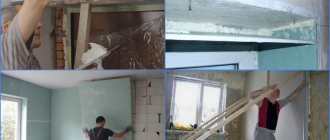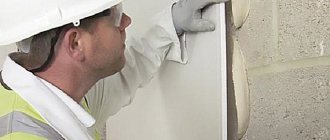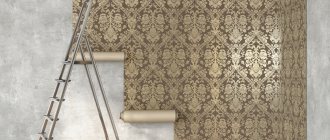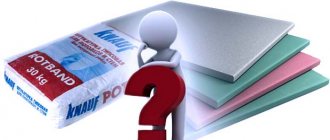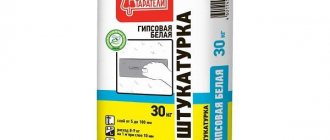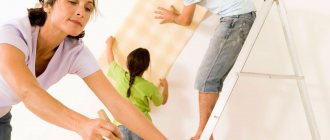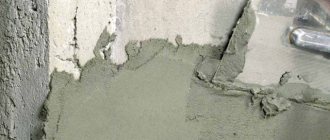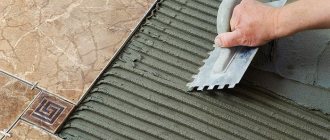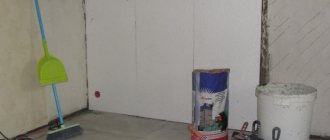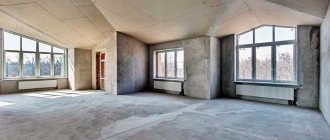Is it possible to use tile adhesive instead of plaster?
There are many types of tile adhesive on the modern market, differing in cost.
There is constant debate among craftsmen and ordinary people whether it is possible to use tile adhesive instead of plaster. Sometimes this question arises due to the presence of a large amount of glue purchased for repairs. This is just a problem of saving money - making the most of available building materials.
But in some cases this is a real consideration of all the advantages and comparison of prices for specialized compounds. Plastering with tile adhesive is sometimes cheaper than putty. However, it is worth considering that not all mixtures are suitable for this type of finishing.
Some manufacturers indicate on the packaging the possibility of using this composition as plaster.
Exceptions
Read also: top 2 headphones for streaming (2021)
But, as always in our language, nuances appear:
- “The officer gave the order to catch up.”
The call to align, addressed to the formation, calls on the soldiers not to become the same height, but to form a neat line.
- “Be equal! Attention! Alignment to the right!
Important! Writing “equal” is a mistake!
- “Look up to your uncle - thanks to honest work, intelligence and endurance, he achieved great success.”
To be like someone does not mean to wear shoes of the same size, but to adopt qualities and habits. Other exceptions: “level”, “peer”.
- “You should trim your hair every three months to keep it healthy.”
“Trim the bushes like this.”
For nouns, for example, “hair”, “bushes”, both words in question are applied. In one case, the emphasis is on size (length), in the other - on appearance.
Tile adhesive and its properties
Slab adhesive is a powder that is diluted with water to a paste. You can also find ready-made mixtures that can be immediately applied to the surface to be treated. Originally, tile adhesive was a simple mixture of cement and sand.
However, modern technologies have made it possible to make the composition more durable and reliable. Thanks to its composition, this building material has become a universal tool for many construction and repair works.
Types of glue
Depending on the presence of components in the adhesive mixture, several types of tile adhesive are distinguished:
- Cement powder mixed with resins.
- Ready-made dispersion solutions.
- Polymer adhesive known as “liquid nails”.
The most common type is dry mixes. This is due to their availability, relatively low price and ease of use. Some mixtures contain resins and synthetic additives, which improves their performance characteristics.
Pros and cons of this solution
Tile adhesive cannot always be used as plaster. Before plastering the walls, you should familiarize yourself not only with the positive aspects of such finishing, but also with possible problems.
| № | Stage | Work performed |
| № | Stage | Work performed |
| 1 | foundation preparation | cleaning the surface from loose putty and dirt; priming in two layers; |
| 2 | installation of beacons | beacons are set in the 1st plane horizontally |
| 3 | preparing the solution | the mixture is diluted with water until the desired consistency is obtained |
| 4 | wall application | apply the first layer up to 1 cm thick with a trowel; the following layers can be applied as a rule on the hardened previous ones until the desired result is obtained; finishing the corners - at the end. |
Advantages of finishing walls with tile adhesive:
- Reliable adhesion to concrete and brick surfaces.
- The thick solution adheres well to a vertical surface.
- Convenient and easy to use.
- Resistance to humidity, elevated temperatures and frost.
- The durable composition is resistant to mechanical stress.
- Suitable for outdoor use.
In terms of its properties, tile adhesive is superior to gypsum compounds and putties.
When deciding whether tile adhesive can be used as plaster in a bathroom or other rooms with high humidity, the answer will be positive. It is this kind of finishing base that will be most acceptable in these places. The slab adhesive is moisture resistant and prevents water from penetrating the walls. Such plaster will provide reliable protection against fungus and mold.
At what stage should communications be laid?
- Cables, as well as steel and polymer pipes with permanent connections and an estimated service life of at least 40 years can be embedded in a wet screed.
- When installing a dry screed, pipes and cables must be protected from contact with the backfill with strong boxes and casings to avoid damage from friction during shrinkage.
- Floors on joists, as well as modular raised floors, make it easy to lay communications. During the work, it is important not to reduce the cross-section of the joists and not to increase the pitch of the supports.
Leveling walls with tile adhesive
Defects on the wall can be easily eliminated with tile adhesive. Also, leveling using this method is applicable in those places where there are traces of previous finishing.
It is not always possible to effectively remove dried glue, and it will take a lot of time. It is enough to plaster the adhesive mounds, and then it will be convenient and easy to install the new cladding.
Alignment occurs as follows:
- The foundation is being prepared.
- One or two layers of plaster are applied. In this case, beacons must be installed
- The surface is thoroughly dried.
- The final coating is being carried out.
Preparing the base
Despite the unsurpassed properties of tile adhesive, the base must be properly prepared before work. Measures to be taken to prepare the walls:
- Remove old finishes: wallpaper, whitewash, peeling paint, etc.
- If possible, remove all metal elements.
- Clean the surface from dust and dirt. Otherwise, there will be no proper adhesion to the surface.
- Chips and cracks should be treated with a primer.
For additional protection, it is sometimes necessary to install reinforced mesh
Installation of beacons
If there are small defects on the walls, then you can do without beacons. But for more serious damage that requires the application of a thick layer of plaster, it is necessary to install beacons. This is done using a level according to the following algorithm:
- The most convex place on the surface is determined.
- If it is impossible to remove the protrusion, it will serve as a guide for the beacon.
- Planks are made from gypsum.
Beacons are installed at a distance of 1 meter from each other
Preparation of the solution
How to properly dilute the adhesive powder is indicated by the manufacturer on the packaging. You need to read the recommended proportions and follow a few simple steps:
- Pour warm water into a container.
- Add dry mixture.
- Mix the ingredients thoroughly using a construction mixer.
- Continue mixing the solution for 4-5 minutes.
- Leave to react for a few minutes (about 10-15).
- Stir the solution again with a mixer.
Example sentences
The following are sentences containing the word “align”:
- It was not easy to even out the results of the game, because the participants in the fight were determined.
- The teams tied the game, and by the end there was no winner - the game ended in a draw.
- Their success could not be equalized, since the capabilities of each were different from the beginning.
- The sequence in the game was aligned using a program invented by Maxim last year.
- It was only a hundred years ago that the political freedoms of men and women were equalized.
- The goal of the project was to level the river levels, to make the water level equal.
- In the army, everyone is required to align on the same line during formation.
- It was not easy to equalize the values of the roots in the two sides of the equation, so the topic seemed difficult to us.
How to plaster with tile adhesive
The plastering process must follow the manufacturer's recommendations. Rules for working with tile adhesive:
- It is necessary to observe the temperature regime in the room: from 5 to 30 degrees Celsius.
- The amount of liquid in the solution should not be more than recommended.
- The thickness of the applied layer of plaster should not be more than 1 cm.
- The finished mixture should be used within 20-25 minutes after dilution.
- Each layer must be applied to a thoroughly dried surface.
- It is necessary to use glue intended for finishing as plaster. Some formulations have limitations in such use.
- If the layer exceeds 1 cm, then sand can be added to the solution. However, this will not always help solve the problem. A thick layer of plaster may crack over time, so the recommended thickness of an individual layer must be followed.
- A primer must be applied between each coat.
Adhesive like plaster should be used with sand added
✅ Working with paper-based wallpaper
Paper wallpaper and drywall are far from the best combination, which is not always possible to destroy. This is especially true if the wall covering was unknowingly glued to unplastered drywall. Or PVA glue was used as a fastening composition.
The paper base of the wallpaper with the cardboard surface of the gypsum board can become so bonded that it is no longer possible to “separate” them. For this reason, advice for the future: if you want to save on putty, glue exclusively non-woven wallpaper to the gypsum board.
The only solution to the problem of how to remove paper wallpaper from drywall is to use the steaming method. Ideally, it is better to use a special wallpaper steamer. It simultaneously performs two functions: warms up and moisturizes the surface. In the absence of one, you can use:
- household iron with a steam function;
- a hair dryer set to supply the hottest air possible, in combination with irrigation from a spray bottle;
- steam mop.
The devices are convenient because they allow moisture to evenly penetrate the structure of the applied coating, moistening the old dried glue and without damaging the base.
If steaming does not give the desired result, the only way out of this situation is to cover the old, tired wallpaper with a primer, and stick new “clothes” on top of it.
Types of tile adhesive
The range of mixtures for slabs is quite large. Many manufacturers of building materials are trying to market their unique tile adhesive composition. Moreover, under one brand, entire lines of mixtures are produced, in which each composition differs in certain characteristics.
There are several types of tile adhesive:
- Universal. Suitable for work of medium complexity.
- Moisture resistant. It is used for finishing swimming pools, shower rooms and other rooms in contact with water.
- With enhanced formula. Characterized by the highest adhesion and strength.
- Facade. The most important property is frost resistance.
- Heat resistant. Used in the construction of fireplaces and stoves.
The moisture-resistant composition has additional substances that prevent the appearance of fungus and mold.
Applying tile adhesive as plaster is not a panacea. However, this method is loved by many craftsmen for its accessibility and ease of use. In addition, the performance characteristics of some types of glue are significantly superior to specialized compounds.
Is it possible to level the floor immediately during installation?
On wooden floors, tilers use a mixture of glue and wood sawdust, which allows the floor to be leveled gradually, layering centimeter by centimeter. When laying tiles, experienced craftsmen level the surface along with the cladding. This allows them to save time. Only specialists do this, since they can control the level of installation in various ways. Using an adhesive composition, they can even level walls.
Floor leveled with glue under laminate
It is better to carry out any leveling yourself using the method described above, since it provides a complete guarantee of creating a flat surface for installing any covering, both laminate, linoleum, and tiles. Surface leveling is carried out when repairing and replacing one coating with another, as well as when finishing the floor in a new building.
In the first case, the old floor screed is improved, and in the second, the builders' flaws are removed if the subfloor is not made correctly. In any of these cases, the laminate will not lie flat on the floor, so you will have to solve the problem.
